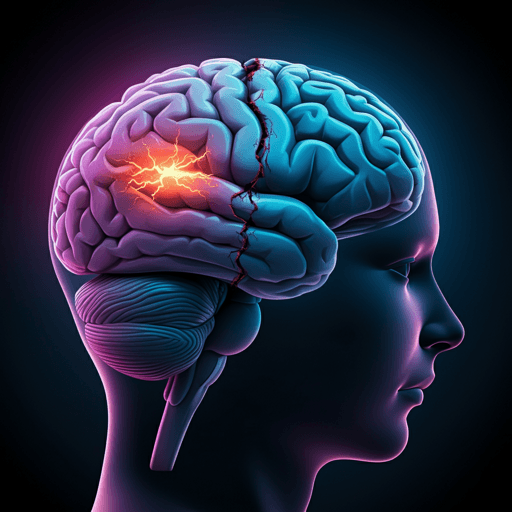
Medicine and Health
The mediating effect of the amygdala-frontal circuit on the association between depressive symptoms and cognitive function in Alzheimer's disease
Y. Du, S. Zhang, et al.
Discover how abnormalities in the amygdala–frontal circuit link depressive symptoms and cognitive decline in Alzheimer's disease, revealing potential treatment targets. This study, conducted by Yang Du, Shaowei Zhang, Qi Qiu, Yuan Fang, Lu Zhao, Ling Yue, Jinghua Wang, Feng Yan, and Xia Li, found reduced amygdala–IFG connectivity and lower left uncinate fasciculus FA mediating symptom–cognition effects.
~3 min • Beginner • English
Introduction
Alzheimer's disease (AD) primarily manifests as cognitive impairment, and up to 80% of patients exhibit behavioral and psychological symptoms of dementia (BPSD). Depressive symptoms are among the most common BPSD (prevalence ~37–46%) and are associated with more impaired cognitive function and faster decline. The amygdala-frontal circuit, implicated in emotional regulation and cognitive integration, shows functional and microstructural abnormalities in depression and AD, but how these alterations contribute specifically to depressive symptoms in AD (ADD) remains unclear. Prior rs-fMRI studies suggest decreased amygdala connectivity with frontal regions (medial prefrontal cortex and inferior frontal gyrus, IFG) in ADD, and one study indicated amygdala-middle frontal gyrus FC mediated depression-cognition relationships, though ADD-specific FC changes were not directly compared. DTI studies implicate the uncinate fasciculus (UF) as the key white matter pathway between amygdala and frontal cortex, with lower fractional anisotropy (FA) in AD and associations with cognition and depressive severity in major depression, but the UF’s detailed trajectory abnormalities in ADD are unknown. This study aimed to: (1) compare amygdala-based FC among ADD, ADND, and healthy controls; (2) quantify bilateral UF diffusion properties along tract nodes using AFQ; and (3) test whether functional and microstructural abnormalities mediate the relationship between depressive symptoms and cognitive function in ADD. The hypothesis was that amygdala-frontal circuit abnormalities would mediate the link between depressive symptoms and cognition in ADD.
Literature Review
Prior work indicates abnormal amygdala-frontal circuitry in depression and AD. Rs-fMRI studies show decreased amygdala connectivity to medial prefrontal cortex and IFG in ADD versus ADND, suggesting impaired top-down emotional regulation. Neuroimaging evidence in ADD highlights frontal lobe connectivity abnormalities with the amygdala. A previous study reported that amygdala FC with middle frontal gyrus mediated the relationship between depressive symptoms and cognitive function in AD, implying the amygdala-frontal circuit as a mediator, though ADD-specific FC changes were not isolated. DTI studies demonstrate the UF, linking amygdala and frontal regions, has lower FA in AD and correlates with cognitive function. In depression, left UF integrity relates to severity of depressive symptoms and cognition. AFQ enables node-wise tract profiling to detect focal microstructural abnormalities along UF trajectories, which have not been characterized in ADD. Broader literature connects amygdala-prefrontal circuit disruptions with depression pathophysiology and shows structural connectivity can underlie functional connectivity patterns. Evidence also suggests left-lateralized amygdala and UF involvement in emotional and cognitive processing.
Methodology
Design and participants: Cross-sectional study of 180 individuals: 60 ADD patients, 60 ADND patients, and 60 healthy controls (HC), recruited from the SHAPE cohort and community. Groups were matched on age, sex, and education. AD diagnosis followed NIA-AA guidelines; MMSE used to assess cognitive impairment with inclusion MMSE ≤24. Depression in AD diagnosed per provisional criteria; to avoid confounding from prior depression, AD patients with youth-onset depression were excluded. Depressive symptom severity was measured by GDS-30; ADD required GDS-30 ≥10 and ADND GDS-30 <10. Only mild AD (CDR=0.5 or 1) were included. HC inclusion: no neurological/psychiatric disorders, MMSE ≥27, GDS <10.
Exclusion criteria: other dementias; history of major psychiatric disorders (depression, schizophrenia, bipolar disorder); systemic diseases causing cognitive impairment; MRI contraindications; inability to complete assessments. Ethics approval obtained; written informed consent collected; procedures followed the Declaration of Helsinki.
MRI acquisition: 3T Siemens scanner with 8-channel head coil. Structural T1 MPRAGE: TR/TE=2530/3.5 ms, flip angle 9°, matrix 256×256, voxel 1×1×1 mm³, slice thickness 1.2 mm. Resting-state fMRI: gradient EPI, TR/TE=2000/30 ms, flip angle 90°, matrix 74×74, voxel 3×3×3 mm³, slice thickness 3 mm; 8 minutes, 200 volumes. DTI: single-shot spin-echo EPI, 64 directions (b=1000 s/mm²) + b0, TR/TE=5620/106 ms, matrix 126×126, voxel 2×2×2 mm³, slice thickness 2 mm, 74 slices; axial sections parallel to AC-PC; total DTI scan 6 minutes.
Preprocessing (rs-fMRI): DPARSF pipeline. First 10 time points discarded; slice timing correction; motion correction with Friston 24-parameter model; motion thresholds: <2 mm or 2° in any direction, mean framewise displacement <0.5 mm. Normalization to MNI space via DARTEL; resampling to 3×3×3 mm³; smoothing with FWHM=6 mm; linear trend removal; temporal band-pass 0.01–0.08 Hz. Nuisance regression included head motion parameters, CSF, and white matter signals.
Preprocessing (DTI): FSL toolbox. Eddy current and motion correction via affine co-registration to b0; diffusion gradient reorientation; brain extraction using BET (fractional intensity threshold 0.2). Tensor fitting with FDT; maps computed for FA, mean diffusivity (MD), radial diffusivity (RD), and axial diffusivity (AxD).
Seed-based FC analysis: REST toolkit used. Bilateral amygdala seeds defined using SPM Anatomy Toolbox. Time series averaged across voxels within each seed; voxel-wise Pearson correlations computed with whole brain; correlation coefficients Fisher z-transformed for statistics.
Automated fiber quantification (AFQ): Whole-brain deterministic tractography performed. Tracking terminated at FA<0.2 or when the minimum angle between steps exceeded 30°. UF segmentation via waypoint ROI procedure; refinement using tract probability maps; fiber cleaning via outlier elimination algorithm. Bilateral UF tracts sampled at 100 isometric nodes; diffusion metrics extracted along nodes.
Statistics: Data tested for normality and homogeneity. Group comparisons of demographics and clinical variables: one-way ANOVA for age and education; chi-square for sex; ANOVA with post-hoc tests (Tukey) for MMSE, CDR, GDS. In ADD, partial correlations (controlling age, sex, education) assessed relationships between GDS-30 and MMSE. FC group differences assessed via ANOVA controlling age, sex, education; voxel-wise non-parametric permutation tests (5000 permutations) with TFCE correction at P<0.05; significant regions used as masks for post-hoc two-sample t-tests. Mean z-score FC values extracted from regions differing between ADD and ADND; partial correlations with MMSE and GDS controlling covariates. UF node-wise diffusion metrics (FA, MD, RD, AxD) compared via ANOVA with Tukey post-hoc tests across nodes 1–100 for each tract; multiple comparisons controlled by FDR across 200 tests (100 nodes × 2 tracts), significance P<0.05 (two-tailed). Mediation analyses in ADD used SPSS PROCESS, with age, sex, education as covariates; bootstrap 10,000 samples; significance determined by 95% CI excluding zero.
Key Findings
Sample characteristics: 60 ADD, 60 ADND, 60 HC; no group differences in age (P=0.82), sex (P=0.75), education (P=0.87). MMSE and CDR were higher in HC than both AD groups (P<0.001); no difference in MMSE/CDR between ADD and ADND. GDS-30 was higher in ADD vs ADND and HC (P<0.001).
Functional connectivity: ANOVA revealed significant group differences in FC between bilateral amygdala and bilateral MCC, bilateral STG, right SMA, right PHG, and left IFG. ADD vs ADND: decreased amygdala FC with left IFG for both seeds (left amygdala IFG cluster: MNI −48, 27, −9; T=−4.58; right amygdala IFG cluster: MNI −51, 33, 9; T=−4.67). ADD vs HC: widespread decreases with MCC, STG, PHG, SMA, and left IFG. ADND vs HC: decreases primarily with MCC, STG, PHG.
UF microstructure (AFQ): Left UF frontal segment showed significant differences in FA at nodes 64–97 among groups (PFDR<0.001). Post-hoc: ADD<ADND (PFDR=0.019) and ADD<HC (PFDR<0.001); ADND<HC (PFDR=0.020). Left UF MD differed at nodes 71–100 (PFDR<0.001); both ADD and ADND differed from HC, but ADD vs ADND not significant. Left UF RD differed at nodes 66–100 (PFDR<0.001); ADD and ADND lower FA vs HC; ADD vs ADND not significant for MD/RD. No AxD differences in left UF. Right UF: FA differences at nodes 80–100 (PFDR=0.003); ADD and ADND < HC (PFDR=0.002 and 0.005), but ADD vs ADND not significant. Right UF MD differences at nodes 90–100 (PFDR=0.002); ADD and ADND differed from HC; RD differences at nodes 79–100 (PFDR<0.001); no AxD differences; no ADD vs ADND differences for MD/RD.
Correlations (ADD, partial controlling age/sex/education): Depressive symptoms negatively correlated with cognition (GDS vs MMSE: r=−0.445, P<0.001). FC (left amygdala–left IFG) positively correlated with MMSE (r=0.349, P=0.006) and negatively with GDS (r=−0.273, P=0.035). Left frontal UF FA (nodes 64–97) positively correlated with MMSE (r=0.388, P=0.002) and negatively with GDS (r=−0.274, P=0.034). No significant correlations for other UF metrics.
Mediation (ADD): Left amygdala–left IFG FC partially mediated the relationship between depressive symptoms (GDS) and cognitive function (MMSE): indirect effect=−0.0670, 95% bootstrapped CI [−0.1655, −0.0023], P<0.05; proportion mediated ≈15%. Left frontal UF FA (nodes 64–97) partially mediated GDS→MMSE: indirect effect=−0.0790, 95% CI [−0.1702, −0.0048], P<0.05; proportion mediated ≈18%.
Discussion
Findings demonstrate that ADD patients exhibit decreased amygdala–IFG functional connectivity and reduced FA in the left frontal UF compared to ADND, and these abnormalities partially mediate the adverse association between depressive symptoms and cognitive function. Reduced amygdala–IFG FC suggests impaired top-down regulatory control by frontal cortex over limbic regions, contributing to emotional dysregulation in ADD. The mediation through amygdala–IFG FC aligns with evidence linking this circuit to episodic memory and supports a pathway whereby depression impacts cognition indirectly via memory-related processes. The microstructural disruption of the UF, the principal amygdala–frontal structural pathway, provides a substrate for observed FC deficits, consistent with structure–function coupling. Node-wise AFQ localized abnormalities to the frontal portion of the left UF, highlighting focal tract segments as potential biomarkers for ADD. Lateralization of effects to the left amygdala–frontal circuit is consistent with literature on left amygdala’s role in voluntary emotional appraisal and left UF’s involvement in socio-emotional and cognitive functions. These results suggest that circuit-focused interventions, potentially including neuromodulation targeting IFG (e.g., rTMS), might ameliorate cognitive deficits associated with depressive symptoms in AD.
Conclusion
This multimodal neuroimaging study is the first to show that both functional connectivity (amygdala–IFG) and microstructural integrity (left frontal UF FA) of the amygdala-frontal circuit are specifically impaired in AD patients with depressive symptoms and partially mediate the relationship between depression severity and cognitive function. The localized left frontal UF abnormalities identified via AFQ and reduced amygdala–IFG FC provide candidate biomarkers and therapeutic targets for ADD. Future research should use longitudinal designs to establish causality and track dynamic changes in depressive symptoms, cognition, and circuit integrity over time, and employ subregional analyses of the amygdala to delineate discrete network contributions. These efforts may refine circuit-based interventions and improve outcomes in ADD.
Limitations
The study is cross-sectional, limiting causal inference regarding the relationships among depressive symptoms, cognition, and amygdala-frontal circuit abnormalities; dynamic changes over time were not assessed. The amygdala is heterogeneous with distinct subregions that may have different connectivity patterns, but subregional analyses were not conducted, potentially obscuring finer-grained network effects.
Related Publications
Explore these studies to deepen your understanding of the subject.







